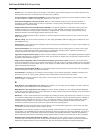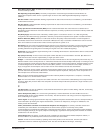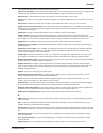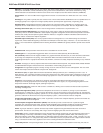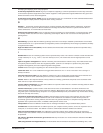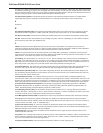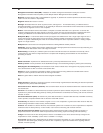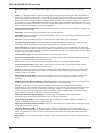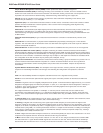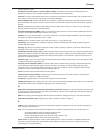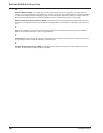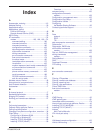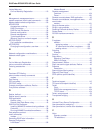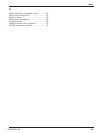
RASFinder RF300E/RF310E User Guide
RF300E/RF310E194
Simple Network Management Protocol (SNMP): TCP/IP protocol that allows network management.
Simultaneous Voice Data (SVD): A technology for letting a user send data via a modem, and use a handset to talk to
another user at the same time over the same connection. The alternative, making a second call, can be expensive or even
impossible. The uses for SVD are telecommuting, videoconferencing, distant learning, tech support, etc.
Stop Bit: One of the variables used for timing in asynchronous data transmission. Depending on the devices, each
character may be trailed by 1, 1.5, or 2 stop bits.
Superframe (D4): A T1 transmission format that consists of 12 DS1 frames, or 2316 bits. A DS1 frame consists of 193 bit
positions. A frame overhead bit is in the first position, and it is used for frame and signaling phase alignment only.
Subscriber Loop: See “Local loop”.
Switched 56: A circuit-switched (full duplex digital synchronous data transmission) service that lets you dial a number and
transmit data to it at 56K bps. It is a relatively low cost service, widely used in North America for telecommuting,
videoconferencing and high speed data transfers. Many phone companies are (or will be) phasing out Switched 56 in favor
of ISDN service.
Switched Virtual Circuit (SVC): A type of data transmission where the connection is maintained only until the call is
cleared.
Switched Line: In communications, a physical channel established by dynamically connecting one or more discrete
segments. This connection lasts for the duration of the call, after which each segment can be used as part of a different
channel. Contrast with leased line.
Switched Network: A network in which a temporary connection is established from one point via one or more segments.
Synchronous Data Link Control (SDLC): A discipline conforming to subsets of the Advanced Data Communications
Control Procedures (ADCCP) of the American National Standards Institute (ANSI) and High-level Data Link Control (HDLC)
of the International Organization for Standardization, for managing synchronous, code-transparent, serial-by-bit information
transfer over a link connection. Transmission exchanges may be duplex, or half-duplex over switched or nonswitched links.
The configuration of the link connection may be point-to-point, multipoint, or loop.
Synchronous Transmission: The transmission of data which involves sending a group of characters in a packet. This is a
common method of transmission between computers on a network or between modems. One or more synchronous
characters are transmitted to confirm clocking before each packet of data is transmitted. Compare to Asynchronous
Transmission.
Systems Network Architecture (SNA): The description of the logical structure, formats, protocols, and operational
sequences for transmitting information units through, and controlling the configuration and operation of, networks.
T
Tariff: The rate/availability schedule for telephone and ISDN services from a regulated service provider.
TCP/IP: A set of communication protocols that support peer-to-peer connectivity functions for both local and wide area
networks.
T Carrier: The generic name for a digitally multiplexed carrier system. In the North American digital hierarchy, a T is used to
designate a DS (digital signal) level hierarchy. Examples: T1 (DS1) is a 1.544 M bps 24-channel designation. In Europe, T1
is called E1. The T Carrier system was originally designed for transmitting digitized voice signals, but has since been
adapted for digital data applications.
T1: A digital transmission link capable of 1.544M bps. T1 uses two pairs of normal UTP, and can handle 24 voice
conversations, each digitized at 64K bps. T1 is a standard for digital transmission in the U.S., Canada, Japan and Hong
Kong. T1 is the access method for high-speed services such as ATM, frame relay, and SMDS. See also T Carrier, T1 line
and FT1.
T1 Channel Tests: A set of diagnostics that vary by carrier, used to verify a T1 channel operation. Can include Tone, Noise
Level, Impulse Noise Level, Echo Cancelers, Gain, and Crosstalk testing.
T1 Framing: To digitize and encode analog voice signals requires 8000 samples per second (twice the highest voice
frequency of 4000 Hz). Encoding in an 8-bit word provides the basic T1 block of 64K bps for voice transmission. This “Level
0 Signal, as its called, is represented by “DS-0”, or Digital Signal at Level 0. 24 of these voice channels are combined into a
serial bit stream (using TDM), on a frame-by-frame basis. A frame is a sample of all 24 channels; so adding in a framing bit
gives a block of 193 bits (24x8+1=193). Frames are transmitted at 8000 per second (the required sample rate), creating a
1.544M (8000x193=1.544M) transmission rate.
T1 Line: A digital communications facility that functions as a 24-channel pathway for data or voice transmission. A T1 line is
composed of two separate elements: the Access element and the Long Haul element.
T1 Mux: A device used to carry many sources of data on a T1 line. The T1 mux assigns each data source to distinct DS0
time slots within the T1 signal. Wide bandwidth signals take more than one time slot. Normal voice traffic or 56/64K bps
data channels take one time slot. The T1 mux may use an internal or external T1 DSU; a “channel bank” device typically



